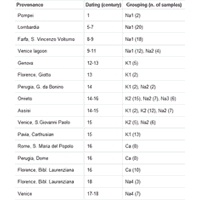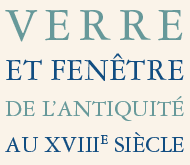Introduction
The chemical analyses available today allow for a sufficiently good understanding of the evolution of Italian window glass compositions from the Roman period to the 18th century. In this paper the results of the chemical analyses of more than 170 samples of window glass from several Italian sites published by several authors are summarised in a data et and discussed. Only reliable quantitative analyses are considered. The data et allowed us to draw some first conclusions concerning window glass use in Italy in the considered period.
The samples include fragments found in archaeological excavations (discs and flat glass pieces) as well as glass pieces originating from still extant stained glass windows and from non-figurative windows. The original glass samples belonged to churches, monasteries and also to secular buildings. As to the forming process, not discussed in this paper, cylinder or disc drawn glass, and simply poured and pressed glass are represented.
The analytical data form a first database on Italian window glass compositions. Nevertheless, some caution is necessary when treating these data. Due to a lack of published compositions, some periods (for instance, the 12-13th centuries) as well as some Italian regions (no samples from southern Italy were analysed) are under-represented. The under-representation may be due either to a difficulty in finding samples of a certain period or to the lack of analyses of existing finds. Furthermore, most of the stained glass window pieces were collected during restoration, where the major interest was to find a relation between the weathering stagete and glass composition. Therefore, many severely weathered pieces were analysed (for instance the glasses belonging to K1 and K2 groups discussed in the following), while more stable glasses are under-represented.
∧ Back to topThe sites

Table 1 : Provenance, dating and compositional grouping of the analysed samples.

Table 2 : San Vincenzo al Volturno, 9th century: composition in wt% of the oxides of window glass fragments.
The provenance and dating, and the number of analysed samples belonging to each compositional group (groups are discussed in the follow) are summarised in table 1. Two Roman large windowpanes (about 50 x 40 cm) from Pompei (1st century A.D.) were analysed by (Vallotto 2002). The analyses of finds dating 5th to 7th centuries excavated in several sites in Lombardia (Northern Italy) are reported in (Uboldi and Verità, 2003). They include fragments of window glass coloured in light hues of green, yellow and blue. The Benedectine abbey of Farfa, one of the most influential monasteries in medieval Europe, is 50 km north-east of Rome. The analysed window glasses found during excavation belong to the late 8th-9th centuries (Brill 1999, Newbay 1991). They are mainly made of light coloured glass. Some pieces were found combined with H-sectioned lead cames. Similar pieces have been found at the San Vincenzo al Volturno abbey founded by monks from Farfa, where a local glass production (pots for glass melting and glass scraps) was as certain observed to have been plasticized (Hodges 1991). Two samples were analysed by Brill (Brill 1999); and seven still yet unpublished analyses kindly given to the author by Ian Freestone, are reported in table 2.
The analyses of Venetian finds are especially important due to evidence for a production continuity in this area from the Roman time until today. They include finds from two island of the Venetian lagoon. The analyses of finds from Torcello, the most ancient settlement in the Venetian lagoon after the end of the Roman Empire are reported in (Verità 2002). Analyses of pieces of a small stained window dated 9th to 11th centuries from the island of San Lorenzo of Ammiana are reported in (Vaghi and Verità, 2004). Later on a lack of four centuries exists in the analyses of Venetian window glass. Subsequent analyses concern the stained glass window (late 15th century) of the church of San Giovanni e Paolo (Hreglich and Verità, 1982) and samples of the 17th-18th centuries of various origin (one window pane from a Venetian shipwreck found in Croatia, fragments of stained non-figurative windows of the church of San Lio, glass discs found in occasional excavations in different sites of the lagoon). These still unpublished analyses are reported in table 3.

Table 4 : Mean chemical composition of the main components of the glasses of the stained windows of Assisi, Perugia, Rome and Florence.
Analyses from Florence include two flat glass pieces inserted by Giotto in the aureola of the 13th century cross of Santa Maria Novella (Santopadre et al., 2002) and the stained windows of the Biblioteca Laurenziana (16th century). These windows were manufactured by Flemish glass masters. They are made of clear glass coloured with yellow silver stain and red grisaille (sanguigna). These still unpublished compositions (analyses by the author), will be the object of a next paper. Therefore, for thesis windows and the still unpublished windows of the Perugia cathedral (16th century stained window made by Flemish glass masters, located in a lateral chapel, north side) and Santa Maria del Popolo in Rome (two 16th century stained windows made by the French master Guillaume de Marcillat) only the mean composition and standard deviation of major components are reported in table 4. In table 4 also the mean composition of three pieces of the windows of Biblioteca Laurenziana replaced during the 18th century are reported. These glasses are easily recognizable due to a different hue (nearly colourless, instead of the original greenish).
Several stained windows of the 14th-15th centuries were restored and the analyses of glass pieces are partially published: the stained windows of Giovanni da Bonino in the apse of the Orvieto cathedral (Verità et al., 2000), the small window by the same author in the National Museum of Perugia (Marabelli et alii., 1987) and several stained windows from the Assisi Basilica. The mean compositions of the unpublished samples (analyses by the author) are reported in table 4.

Table 5 : Abbey of San Fruttuoso of Camogli (Genova), 12th-13th centuries: composition in wt% of the oxides of window glass fragments.
In a still unpublished archaeological excavation of the abbey of San Fruttuoso of Camogli (Genova) uncoloured and green coloured, sharply corroded window glass pieces dated 12th-13th centuries, were found. Their composition determined by the author, is reported in table 5.
Glass pieces from five stained and two non-figurative windows of the Pavia Carthusian Monastery (15th century) were analysed (Azzoni 2005). They were made by French masters in 1428 and1473. Several coloured glasses were multi-layered: beside the red flashed glass, a thin purple layer between two blue layers (a special hue of blue) and pieces made of alternating green and colourless glass were found.


